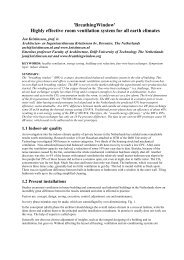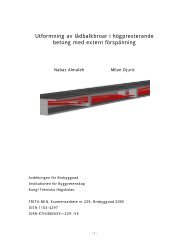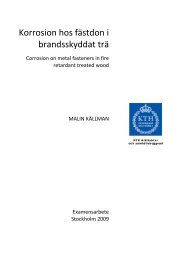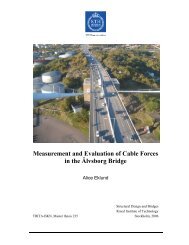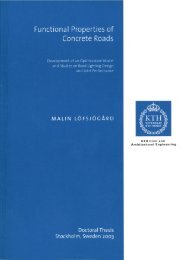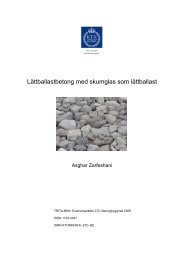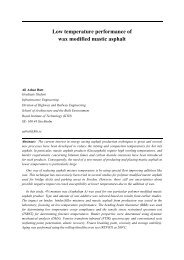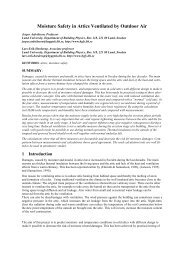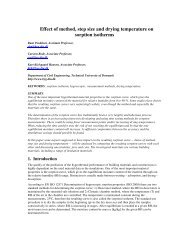Moisture and Mould Damage in Norwegian Houses
Moisture and Mould Damage in Norwegian Houses
Moisture and Mould Damage in Norwegian Houses
You also want an ePaper? Increase the reach of your titles
YUMPU automatically turns print PDFs into web optimized ePapers that Google loves.
Reports of damp spots, water leakage or water damage, <strong>and</strong> mould or mildew from self-report questionnaires, are<br />
used as surrogate measures for the number of fungi <strong>in</strong> several published epidemiologic studies (Kilpela<strong>in</strong>en et al.<br />
2001, Pirhonen et al. 1996, Dales et al. 1991, Platt et al. 1989, Strachan 1988). Several studies have relied on<br />
home <strong>in</strong>spections by professionals (observations) for verify<strong>in</strong>g self reported moisture <strong>and</strong> mould <strong>in</strong> the home<br />
(Haver<strong>in</strong>en et al. 2001, Platt et al. 1989, Dharmage et al. 1999a, Verhoeff et al. 1994). Dharmage et al. 1999b<br />
<strong>and</strong> Garrett et al. 1998 measured the presence of fungal propagules <strong>in</strong> air <strong>and</strong> demonstrated that observed house<br />
characteristics, such as visible mould or dampness patches, have validity as measures of mould concentrations<br />
<strong>and</strong> dampness <strong>in</strong> homes. Dharmage et al. 1999b showed that higher total airborne fungal concentrations were<br />
associated with reported visible mould.<br />
Fungal exposure <strong>and</strong> its association with moisture damage <strong>in</strong> a build<strong>in</strong>g are complex <strong>and</strong> multifaceted. Many<br />
types of fungal species are reported to grow <strong>in</strong> the <strong>in</strong>door home environment (IOM 2004). One way to provide a<br />
better underst<strong>and</strong><strong>in</strong>g of the <strong>in</strong>fluence of residential characteristics (<strong>and</strong> behaviour) on fungal levels is to clarify<br />
the def<strong>in</strong>itions of “fungal levels.” Most studies use total airborne fungi concentrations or report a dom<strong>in</strong>ant type<br />
of fungi species, such as Cladosporium or Aspergillus, <strong>in</strong> their exposure assessment analyses. Li <strong>and</strong> Kendrick<br />
1995 found significantly higher airborne fungal spore counts of specific species (Aspergillus/Penicillium,<br />
Cladosporium, unidentified basidiospores, etc.) <strong>in</strong> damp residences (def<strong>in</strong>ed as homes with visible mould, water<br />
damage, or water <strong>in</strong> the basement). Fungi can grow only on a surface or <strong>in</strong> a substrate. Many conditions of the<br />
surround<strong>in</strong>g environment (e.g., relative humidity <strong>and</strong> temperature) affect fungal growth by <strong>in</strong>creas<strong>in</strong>g or<br />
decreas<strong>in</strong>g the dry<strong>in</strong>g potential of the substrate. In general, water requirements for fungi are species specific.<br />
Exposure assessments may prove more useful if a broad group of fungal species is selected accord<strong>in</strong>g to their<br />
nutrient requirements <strong>and</strong> substrate characteristics, <strong>in</strong>clud<strong>in</strong>g water availability.<br />
As studies <strong>in</strong>creas<strong>in</strong>gly support the presence of health risks associated with moisture related agents (microbes<br />
<strong>and</strong>/or chemicals), there is a strong need for underst<strong>and</strong><strong>in</strong>g fungal concentrations <strong>and</strong> physical measurements as<br />
they relate to the microenvironment (associations between build<strong>in</strong>g characteristics <strong>and</strong> mould growth).<br />
Such knowledge is important to make future prevention of mould growth <strong>in</strong> new <strong>and</strong> already exist<strong>in</strong>g houses<br />
possible. S<strong>in</strong>ce 20-30% of the exist<strong>in</strong>g build<strong>in</strong>gs are affected by moisture problems (IOM 2004) we need<br />
knowledge for measures <strong>in</strong> such build<strong>in</strong>gs, i.e. what should we do <strong>in</strong> a problem build<strong>in</strong>g, how much of the<br />
affected material should be taken away, etc. It may also be a tribute to improve the characterization of commonly<br />
used moisture/mould <strong>in</strong>dicators, such as observation of mould, odours, ventilation <strong>and</strong> reports of moisture <strong>and</strong><br />
water sources <strong>in</strong> the house.<br />
The aim of this study has been the follow<strong>in</strong>g;<br />
• Describe <strong>in</strong>dicators of visible moisture problem <strong>in</strong> build<strong>in</strong>gs observed by <strong>in</strong>spectors <strong>and</strong> compare these to<br />
self reported moisture problem.<br />
• Compare the air humidity <strong>in</strong> bedroom, liv<strong>in</strong>g room, bathroom <strong>and</strong> basement with or without one or more<br />
<strong>in</strong>dicator on a visible moisture problem <strong>and</strong> with or without registered mould growth.<br />
• Compare the <strong>in</strong>fluence of some build<strong>in</strong>g characteristics on the number of houses with one or more<br />
<strong>in</strong>dicator on a visible moisture problem or registered mould growth compared to those without any<br />
registered <strong>in</strong>dications or mould growth.<br />
2. Method<br />
The work presented <strong>in</strong> this paper is part of the study “Prevention of atopy among children <strong>in</strong> Trondheim”<br />
(Jenssen et.al., 2001). Parents of the children that were <strong>in</strong>cluded <strong>in</strong> the “Prevention of atopy”-study were asked<br />
for permission to perform <strong>in</strong>spection of their houses until enough participants had accepted. The survey <strong>in</strong>cludes<br />
both self-reported <strong>in</strong>formation about hous<strong>in</strong>g <strong>and</strong> <strong>in</strong>spections from 205 homes <strong>in</strong> Trondheim, Norway. Indoor air<br />
humidity levels <strong>and</strong> viable mould spores <strong>in</strong> the <strong>in</strong>door air have been measured <strong>in</strong> a selection of the houses. The<br />
houses were r<strong>and</strong>omly selected for each of the four follow<strong>in</strong>g build<strong>in</strong>g types; detached one family houses,<br />
semidetached two family houses, undetached (cha<strong>in</strong>ed) houses <strong>and</strong> apartment build<strong>in</strong>gs. In each house<br />
measurements were made <strong>in</strong> the children bedroom, the liv<strong>in</strong>g room, the most used bathroom <strong>and</strong><br />
basement/cellar.<br />
Six professional <strong>in</strong>spectors performed visual <strong>in</strong>spections <strong>and</strong> assessments of air humidity levels <strong>and</strong> viable<br />
mould spores <strong>in</strong> the <strong>in</strong>door air. The <strong>in</strong>spectors were bl<strong>in</strong>ded to case-control status of the children liv<strong>in</strong>g <strong>in</strong> the



